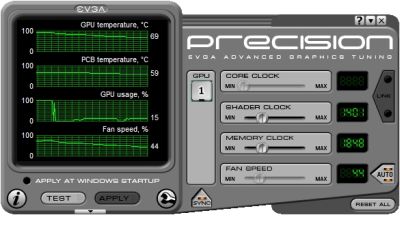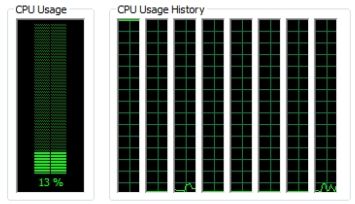Article Index
- 1 – Introduction
- 2 – Demo Pack Download
- 3 – Geometry Instancing Techniques
- 4 – Geometry Instancing Tests
- 5 – Quick Conclusion
4 – Geometry Instancing Tests
Testbed:
– CPU: Intel Core i7 960 @ 3GHz
– RAM: 4GB DDR3 Corsair Dominator 1600MHz
– Mobo: Gigabyte GA-X58A-UD5
– PSU: Antec TPQ 850W
– OS: Windows 7 64-bit
– GeForce driver: R257.21
– Radeon driver: Catalyst 10.6
Graphics cards:
– EVGA GTX 480
– Radeon HD 5870 reference board
For each test, I read the GPU usage with EVGA Precision and the CPU usage with Windows task manager:


12% or 13% means one logical CPU core is fully used.
Here are the results (default resolution: 1024×600 and default camera position):
20,000 instances x 18 tri/instance = 360,000 tri
Radeon HD 5870:
– F2: FPS=43, GPU=68%, CPU=12%
– F3: FPS=55, GPU=88%, CPU=12%
– F4: FPS=45, GPU=25%, CPU=12%
– F5: FPS=134, GPU=22%, CPU=12%
– F6: FPS=139, GPU=24%, CPU=12%
GeForce GTX 480:
– F2: FPS=31, GPU=36%, CPU=12%
– F3: FPS=48, GPU=56%, CPU=12%
– F4: FPS=117, GPU=22%, CPU=12%
– F5: FPS=150, GPU=34%, CPU=12%
– F6: FPS=164, GPU=40%, CPU=12%
20,000 instances, 72 tri/instance = 1,440,000 tri
Radeon HD 5870:
– F2: FPS=42, GPU=67%, CPU=12%
– F3: FPS=55, GPU=87%, CPU=12%
– F4: FPS=45, GPU=26%, CPU=12%
– F5: FPS=133, GPU=37%, CPU=12%
– F6: FPS=139, GPU=41%, CPU=12%
GeForce GTX 480:
– F2: FPS=32, GPU=21%, CPU=12%
– F3: FPS=48, GPU=33%, CPU=12%
– F4: FPS=117, GPU=22%, CPU=12%
– F5: FPS=150, GPU=37%, CPU=12%
– F6: FPS=163, GPU=44%, CPU=12%
20,000 instances, 450 tri/instance = 9,000,000 tri
Radeon HD 5870:
– F2: FPS=43, GPU=69%, CPU=12%
– F3: FPS=54, GPU=87%, CPU=12%
– F4: FPS=45, GPU=64%, CPU=12%
– F5: FPS=79, GPU=99%, CPU=12%
– F6: FPS=73, GPU=99%, CPU=12%
GeForce GTX 480:
– F2: FPS=31, GPU=53%, CPU=12%
– F3: FPS=44, GPU=99%, CPU=12%
– F4: FPS=113, GPU=99%, CPU=12%
– F5: FPS=114, GPU=99%, CPU=12%
– F6: FPS=112, GPU=99%, CPU=12%
20,000 instances, 800 tri/instance = 16,000,000 tri
Radeon HD 5870:
– F2: FPS=42, GPU=99%, CPU=12%
– F3: FPS=43, GPU=99%, CPU=12%
– F4: FPS=43, GPU=99%, CPU=12%
– F5: FPS=48, GPU=99%, CPU=12%
– F6: FPS=46, GPU=99%, CPU=12%
GeForce GTX 480:
– F2: FPS=31, GPU=56%, CPU=12%
– F3: FPS=42, GPU=99%, CPU=12%
– F4: FPS=66, GPU=99%, CPU=12%
– F5: FPS=67, GPU=99%, CPU=12%
– F6: FPS=66, GPU=99%, CPU=12%
20,000 instances, 1800 tri/instance = 36,000,000 tri
Radeon HD 5870:
– F2: FPS=22, GPU=99%, CPU=12%
– F3: FPS=22, GPU=99%, CPU=12%
– F4: FPS=22, GPU=99%, CPU=12%
– F5: FPS=22, GPU=99%, CPU=12%
– F6: FPS=22, GPU=99%, CPU=12%
GeForce GTX 480:
– F2: FPS=30, GPU=99%, CPU=12%
– F3: FPS=30, GPU=99%, CPU=9%
– F4: FPS=31, GPU=99%, CPU=12%
– F5: FPS=32, GPU=99%, CPU=12%
– F6: FPS=32, GPU=99%, CPU=12%
100,000 instances, 18 tri/instance = 1,800,000 tri
Radeon HD 5870:
– F2: FPS=9, GPU=67%, CPU=12%
– F3: FPS=12, GPU=85%, CPU=12%
– F4: FPS=10, GPU=23%, CPU=12%
– F5: FPS=33, GPU=21%, CPU=12%
– F6: FPS=37, GPU=20%, CPU=12%
GeForce GTX 480:
– F2: FPS=7, GPU=34%, CPU=12%
– F3: FPS=10, GPU=54%, CPU=12%
– F4: FPS=25, GPU=14%, CPU=12%
– F5: FPS=32, GPU=25%, CPU=12%
– F6: FPS=35, GPU=30%, CPU=12%
100,000 instances, 72 tri/instance = 7,200,000 tri
Radeon HD 5870:
– F2: FPS=9, GPU=67%, CPU=12%
– F3: FPS=12, GPU=85%, CPU=12%
– F4: FPS=10, GPU=24%, CPU=12%
– F5: FPS=33, GPU=35%, CPU=12%
– F6: FPS=37, GPU=41%, CPU=12%
GeForce GTX 480:
– F2: FPS=7, GPU=36%, CPU=12%
– F3: FPS=10, GPU=57%, CPU=12%
– F4: FPS=25, GPU=38%, CPU=12%
– F5: FPS=32, GPU=36%, CPU=12%
– F6: FPS=35, GPU=45%, CPU=12%
100,000 instances, 450 tri/instance = 45,000,000 tri
Radeon HD 5870:
– F2: FPS=9, GPU=69%, CPU=12%
– F3: FPS=12, GPU=90%, CPU=12%
– F4: FPS=10, GPU=65%, CPU=12%
– F5: FPS=17, GPU=99%, CPU=12%
– F6: FPS=16, GPU=99%, CPU=12%
GeForce GTX 480:
– F2: FPS=7, GPU=53%, CPU=12%
– F3: FPS=9, GPU=99%, CPU=12%
– F4: FPS=23, GPU=99%, CPU=12%
– F5: FPS=24, GPU=99%, CPU=10%
– F6: FPS=23, GPU=99%, CPU=8%
100,000 instances, 800 tri/instance = 80,000,000 tri
Radeon HD 5870:
– F2: FPS=9, GPU=99%, CPU=12%
– F3: FPS=9, GPU=99%, CPU=12%
– F4: FPS=9, GPU=99%, CPU=12%
– F5: FPS=10, GPU=99%, CPU=12%
– F6: FPS=10, GPU=99%, CPU=12%
GeForce GTX 480:
– F2: FPS=7, GPU=56%, CPU=12%
– F3: FPS=9, GPU=99%, CPU=12%
– F4: FPS=14, GPU=99%, CPU=7%
– F5: FPS=14, GPU=99%, CPU=7%
– F6: FPS=14, GPU=99%, CPU=6%
100,000 instances, 1800 tri/instance = 180,000,000 tri
Radeon HD 5870:
– F2: FPS=5, GPU=99%, CPU=8%
– F3: FPS=5, GPU=99%, CPU=8%
– F4: FPS=5, GPU=99%, CPU=8%
– F5: FPS=5, GPU=99%, CPU=12%
– F6: FPS=5, GPU usage: 99%, CPU=12%
GeForce GTX 480:
– F2: FPS=6, GPU=99%, CPU=12%
– F3: FPS=6, GPU=99%, CPU=9%
– F4: FPS=7, GPU=99%, CPU=4%
– F5: FPS=7, GPU=99%, CPU=3%
– F6: FPS=7, GPU=99%, CPU=4%
Pingback: OpenGL Geometry InstancingJeGX's Infamous Lab | JeGX's Infamous Lab
It would be interesting to see how the test behave with different instancing methods: instanced array, texture buffer, etc. Also 1800 triangles isn’t so much for the maximum.
Nice work anyway!
Thanks Mr Groove!
I’ll update this demopack with new techniques next time (at least with instanced array). And I’ll increase the number of polygons per instance 😉
FWIW, note that with more triangles, you’ll be hitting harder the triangle setup bottleneck of one triangle per clock cycle. Don’t know for the NVidia GTX 480, but this limit applies for the ATI R5xxx ; I don’t think that going beyond 180M triangles will bring you anything good for this generation of boards.
Nice summary of instanciation techniques and perfs though. Did you try to have finer grained timings with ARB_timer_query extension ?
Cheers
Yes keep these demo and tutorials coming. I enjoy reading them as it keeps me up to date on the newest features I can do with OpenGL. Plus it’s nice to see the old vs. new method of doing the same thing so once can make his own decision on what to do.
Thanks!!! keep up the good work!
20,000 instances x 18 tri/instance = 360,000 tri
Geforce GTX 470@ 700 core /1800 mem
– F2: FPS=18, GPU=20%, CPU=30%
– F3: FPS=40, GPU=21%, CPU=35%
– F4: FPS=68, GPU=15%, CPU=35%
– F5: FPS=96, GPU=19%, CPU=35%
– F6: FPS=101, GPU=24%, CPU=30%
100,000 instances, 1800 tri/instance = 180,000,000 tri
Geforce GTX 470@ 700 core /1800 mem
– F2: FPS=4, GPU=67%, CPU=30%
– F3: FPS=6, GPU=99%, CPU=24%
– F4: FPS=6, GPU=99%, CPU=14%
– F5: FPS=6, GPU=99%, CPU=12%
– F6: FPS=6, GPU=99%, CPU=10%
interesting…CPU usage goes down as GPU goes up..i thought the cpu would be less stressed with the lower geometry count…
I tested with a Radeon HD 2400, Catalyst 10.6.
The F6 technique half-failed: the asteroids are there, rotating, but all shading on them is turned off (all black). But the middle planet is shaded.
I suppose this was not intended.
The driver exposes all the 3 required extensions.
20,000 instances x 18 tri/instance = 360,000 tri
ATI HD4770 @ 940 core / 4800 mem
– F2: FPS=44, GPU=50%, CPU=28%
– F3: FPS=57, GPU=58%, CPU=30%
– F4: FPS=54, GPU=40%, CPU=30%
– F5: FPS=140, GPU=42%, CPU=34%
– F6: FPS=152, GPU=34%, CPU=30% (no shadinng)
100,000 instances, 1800 tri/instance = 180,000,000 tri
ATI HD4770 @ 940 core / 4800 mem
– F2: FPS=5, GPU=99%, CPU=18%
– F3: FPS=5, GPU=99%, CPU=16%
– F4: FPS=5, GPU=99%, CPU=16%
– F5: FPS=4-8, GPU=99%, CPU=12-28%
– F6: FPS=1-6, GPU=99%, CPU=6-28% (no shadinng)
Same thing as Matumbo here. But i have Radeon 4850 on Win7 and Cat. 10.5
F6 – asteroids are all black with all triangle variations (different EXEs).
Could you share your source code please (both C++ and GLSL), in order to learn advanced techniques and programming in OpenGL?
Omg, make a GRAPH, not text :p
Completely off topic but I think our friend JegX should make a post about this.
http://www.techreport.com/discussions.x/19216
hay JeGX R u died or what?????
Not publishing any new article from 3 to 4 days???
Fight with GirlFriend?????????
r u alive????????
where can I find the source of this demo ? or a similar source ? I get very bad performance with glDrawElements() (1000 cube instances max ) and glDrawElementsInstanced gives the same result
Yet I get a descent FPS when I run your demo (I’m on ATI 4850, opengl 2.1)
Yeah, the source for this would be really handy!
180 million eh? According to 3dmark 01, my gtx 470 does 400 million.
http://jooh.no/web/GeForce_8600_GT_vs_GTX_470_polygon_performance.png
Instancing as in the article however, does not use as much cpu power, but is also less useful than “real” cpu aware polygons.
the 470 fermi have several setup engines running in parallel instead of just one as all the previous gpus (ati and nvidia)
please delete my previous post
where do i get the source code?
Thanks!